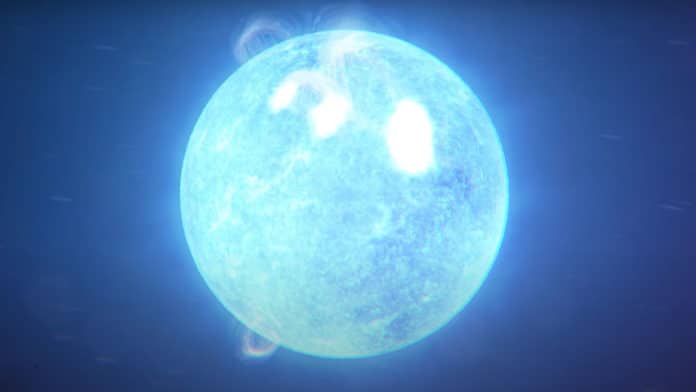A magnetar is an exotic neutron star with an ultra-powerful magnetic field. It is 1,000 times stronger than a normal neutron star.
On Oct. 10, 2020, NASA’s Neil Gehrels Swift Observatory discovered just such an outburst from a new magnetar, called SGR 1830-0645.
NASA‘s Neutron star Interior Composition Explorer (NICER) tracked how three bright, X-ray-emitting hot spots slowly wandered across the magnetar’s surface. In other words, it observed the merging of multimillion-degree X-ray spots on the magnetar’s surface.
At the same time, these spots were found to decrease in size. The largest spot eventually merged with a smaller one, which we hadn’t seen before.
These three moving hot spots likely represent where coronal loops connect to the surface. The interaction between these loops and crustal motion drives the drifting and merging behavior.
George Younes, a researcher at George Washington University in Washington and NASA’s Goddard Space Flight Center in Greenbelt, Maryland, said, “This unique set of observations will help guide scientists to a complete understanding of the interplay between the crust and magnetic field of these extreme objects.”
Credit: NASA/NICER/G. Younes et al. 2022
The measurements also demonstrated that the X-ray emission exhibited three close peaks with every rotation. They were caused when three individual surface regions spun into and out of our view much hotter than their surroundings.
Sam Lander, an astrophysicist at the University of East Anglia in Norwich, United Kingdom, said, “The crust of a neutron star is immensely strong, but a magnetar’s intense magnetic field can strain it beyond its limits. Understanding this process is a major challenge for theorists, and now NICER, and SGR 1830 have brought us a much more direct look at how the crust behaves under extreme stress.”
Zaven Arzoumanian, the NICER science lead at Goddard, said, “Changes in pulse shape, including decreasing numbers of peaks, previously have been seen only in a few ‘snapshot’ observations widely separated in time, so there was no way to track their evolution. Such changes could have occurred suddenly, which would be more consistent with a lurching magnetic field than wandering hot spots.”
Journal Reference:
- George Younes et al. Pulse Peak Migration during the Outburst Decay of the Magnetar SGR 1830-0645: Crustal Motion and Magnetospheric Untwisting. DOI: 10.3847/2041-8213/ac4700
